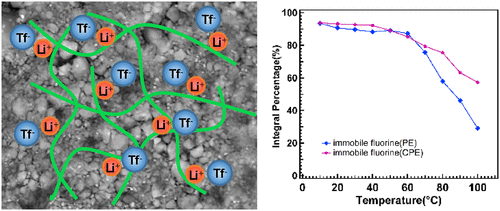当前位置:
X-MOL 学术
›
ACS Appl. Polym. Mater.
›
论文详情
Our official English website, www.x-mol.net, welcomes your feedback! (Note: you will need to create a separate account there.)
A Nuclear Magnetic Resonance Study of Cation and Anion Dynamics in Polymer–Ceramic Composite Solid Electrolytes
ACS Applied Polymer Materials ( IF 5 ) Pub Date : 2020-03-02 , DOI: 10.1021/acsapm.9b01068 Jing Peng 1 , Ye Xiao 1 , David A. Clarkson 2 , Steven G. Greenbaum 2 , Thomas A. Zawodzinski 3, 4 , X. Chelsea Chen 3
ACS Applied Polymer Materials ( IF 5 ) Pub Date : 2020-03-02 , DOI: 10.1021/acsapm.9b01068 Jing Peng 1 , Ye Xiao 1 , David A. Clarkson 2 , Steven G. Greenbaum 2 , Thomas A. Zawodzinski 3, 4 , X. Chelsea Chen 3
Affiliation

|
Polymer–ceramic composite electrolytes are promising for the application of all-solid-state lithium-ion batteries with high energy density and improved safety. In this work, we employ temperature-dependent 7Li and 19F NMR to examine the chemical environment and the dynamics of Li+ cation and triflate anion in poly(ethylene oxide) (PEO)–lithium triflate (LiTf) polymer electrolyte and a composite electrolyte containing 55 vol % doped lithium aluminum titanium phosphate (LICGC). The line shape analysis and spin–lattice relaxation (T1) measurements suggest both the Li+ cations and the Tf– anions reside in two distinct environment: a mobile environment and an immobile environment. In the semicrystalline state, a large ratio (>70%) of immobile Li+ and Tf– is observed. In the melt state, the ratio of mobile cations and anions significantly increases. With the presence of LICGC ceramic, an increased ratio of immobile Li+ and Tf– and reduced mobility of the mobile components are observed, indicating that the ceramic negatively impacts the transport of both the cations and the anions. NMR characterizations are corroborated by conductivity results, which reveal that the intrinsic ionic conductivity of the polymer phase of the composite electrolyte was only 0.15 of the ceramic-free polymer electrolyte at room temperature. These results shed light on the challenges inherent to composite electrolytes with the goal of achieving both enhanced Li+ transference number and ionic conductivity.
中文翻译:

聚合物-陶瓷复合固体电解质中阳离子和阴离子动力学的核磁共振研究
聚合物-陶瓷复合电解质具有高能量密度和更高的安全性,有望用于全固态锂离子电池。在这项工作中,我们使用依赖温度的7 Li和19 F NMR来检查化学环境以及聚(环氧乙烷)(PEO)-三氟甲磺酸锂(LiTf)聚合物电解质和复合材料中Li +阳离子和三氟甲磺酸根阴离子的动力学。含有55体积%掺杂的锂铝钛磷酸盐(LICGC)的电解质。线形状的分析和自旋-晶格弛豫(Ť 1)的测量表明两者栗+阳离子和TF -阴离子存在于两个不同的环境中:移动环境和固定环境。在半结晶状态下,观察到很大的比例(> 70%)的固定态Li +和Tf –。在熔融状态下,可移动阳离子和阴离子的比例显着增加。随着LICGC陶瓷的存在,固定态Li +和Tf –的比例增加。并观察到移动组分的迁移率降低,表明陶瓷对阳离子和阴离子的迁移都产生了负面影响。电导率结果证实了NMR表征,该结果表明,复合电解质的聚合物相的固有离子电导率在室温下仅为不含陶瓷的聚合物电解质的0.15。这些结果揭示了复合电解质固有的挑战,以实现同时增强的Li +转移数和离子电导率为目标。
更新日期:2020-03-02
中文翻译:

聚合物-陶瓷复合固体电解质中阳离子和阴离子动力学的核磁共振研究
聚合物-陶瓷复合电解质具有高能量密度和更高的安全性,有望用于全固态锂离子电池。在这项工作中,我们使用依赖温度的7 Li和19 F NMR来检查化学环境以及聚(环氧乙烷)(PEO)-三氟甲磺酸锂(LiTf)聚合物电解质和复合材料中Li +阳离子和三氟甲磺酸根阴离子的动力学。含有55体积%掺杂的锂铝钛磷酸盐(LICGC)的电解质。线形状的分析和自旋-晶格弛豫(Ť 1)的测量表明两者栗+阳离子和TF -阴离子存在于两个不同的环境中:移动环境和固定环境。在半结晶状态下,观察到很大的比例(> 70%)的固定态Li +和Tf –。在熔融状态下,可移动阳离子和阴离子的比例显着增加。随着LICGC陶瓷的存在,固定态Li +和Tf –的比例增加。并观察到移动组分的迁移率降低,表明陶瓷对阳离子和阴离子的迁移都产生了负面影响。电导率结果证实了NMR表征,该结果表明,复合电解质的聚合物相的固有离子电导率在室温下仅为不含陶瓷的聚合物电解质的0.15。这些结果揭示了复合电解质固有的挑战,以实现同时增强的Li +转移数和离子电导率为目标。



























 京公网安备 11010802027423号
京公网安备 11010802027423号